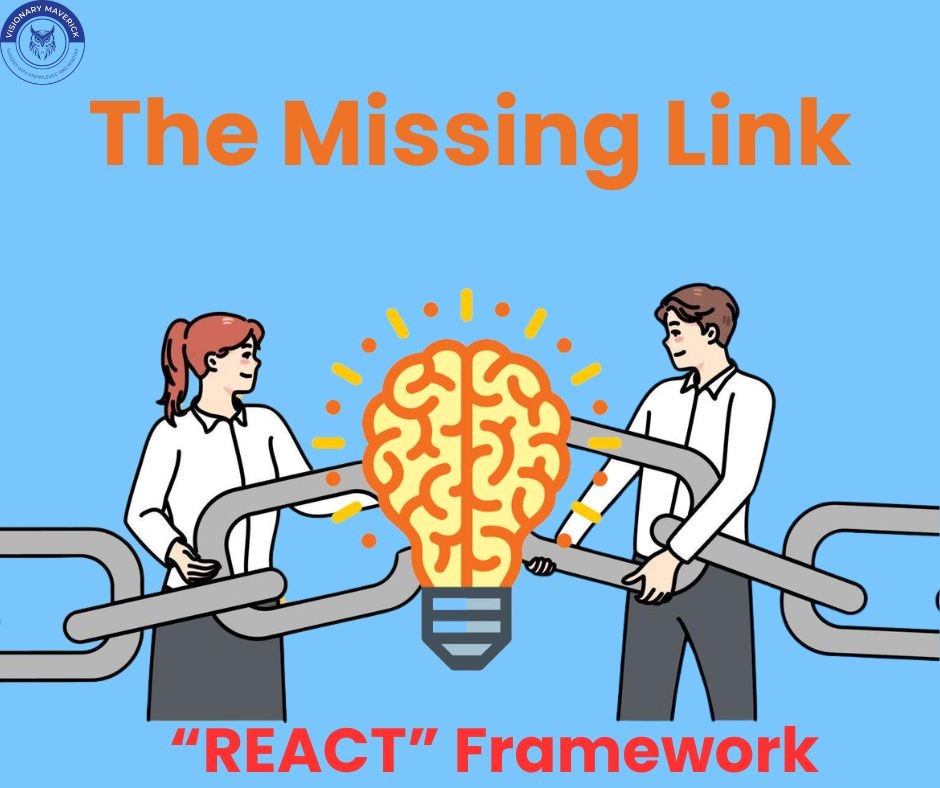Beyond the Buzz: Turning Inspiration into Real Change

“The only limit to our realization of tomorrow will be our doubts of today.”
– Franklin D. Roosevelt
Have you ever walked away from a motivational speech feeling unstoppable, like the world is yours for the taking, only to feel that fire flicker out a few days later? You’re not alone. Inspirational speeches are designed to boost our spirits and ignite our enthusiasm, yet they often fall short when it comes to creating real, lasting change.
Why does this happen? The problem isn’t with the speeches themselves—they’re powerful, crafted with care, and full of passion. The real issue lies in how we, as listeners, handle that motivation. Positive thinking speeches make us feel great in the moment, but they lack a vital ingredient: a clear, actionable plan to help us maintain momentum.
That’s where the REACT framework comes in. I designed this framework to be the missing link between inspiration and action, giving you practical steps to turn that spark of positivity into something tangible and lasting. Whether it’s setting goals, making consistent progress, or creating the right environment, REACT can help you bridge the gap from feeling motivated to living motivated.
Let’s dive in to see how we can transform momentary inspiration into meaningful change.
The Feel-Good Trap: Why We Love Positive Thinking Speeches
We all love the high of a good motivational speech. You know the feeling—your heart is racing, you’re nodding along, and everything seems possible. Positive thinking speeches tap right into that, offering us an instant boost of motivation and hope. In those moments, the words hit home, and we feel empowered, ready to take on the world. It’s as if the speaker has handed us a spark that ignites a fire within.
But here’s the catch: that boost is only temporary. Positive speeches give us a powerful psychological lift, providing quick relief from doubts or discouragement. The rush feels good, and for a while, it seems like we’re well on our way to change. Yet, without taking action, that feeling starts to fade.
This is what I call the “Feel-Good Trap.” Feeling good after hearing a motivational speech can sometimes create a false sense of accomplishment—we feel like we’re making progress simply because we’re inspired. But the truth is, that rush of positivity isn’t enough on its own. Real change needs more than a quick fix; it needs consistent action.
The Missing Link: Why Positive Thinking Alone Falls Short
Positive thinking can be powerful, but it’s only part of the picture. On its own, it’s like putting a fresh coat of paint on a wall with cracks underneath. It looks good for a moment, but without the support of real actions, that positivity is just surface level. In other words, feeling good is one thing, doing something with that feeling is another.
And here’s where most of us struggle: follow-through. We get that initial burst of inspiration from a speech, feel ready to take on big goals, but then life steps in. Without a plan or concrete steps, it’s all too easy for that motivation to slip away, leaving us right back where we started.
This creates a frustrating inner conflict known as cognitive dissonance. We feel inspired, but when things don’t magically change, we wonder why. The disappointment can even make us doubt the value of positive thinking altogether. The truth is, without consistent effort and actionable steps, the most uplifting message will eventually lose its power.
The Real Issue: It’s Not the Speech, It’s You
Here’s the tough truth: the real reason positive thinking speeches don’t create lasting change isn’t because of the message; it’s because of how we respond to it.
For starters, many of us expect too much, too soon. We leave a motivational talk expecting our lives to change overnight, thinking a single spark of inspiration will fix years of habits or challenges. But change, especially the kind that sticks, is rarely that quick.
Then there’s the consistency problem. Positivity is like exercise; it’s most effective when it’s practiced daily. But often, after the initial excitement of the speech fades, so does our commitment to stay positive. Without putting in daily effort, those powerful words end up being a short-lived boost instead of a foundation for real change.
Finally, there’s a big difference between passively consuming inspiration and actively engaging with it. Listening to a speech might lift our spirits, but to create actual change, we have to go beyond just listening, we have to apply those ideas in our lives, step by step. In other words, the real power of a positive message lies in what we do with it.
From Listening to Leading: Introducing the REACT Framework
We’ve all experienced that initial spark of excitement after a positive thinking speech. But how do we keep it going? The answer lies in moving from passive listening to active leading with a structured approach. Here’s the REACT framework: a set of simple, actionable steps to help you turn those powerful words into meaningful, lasting change.
R – Reflect to Perfect: Find the Deeper Message
It’s easy to get caught up in the feel-good vibe of a speech, but the true power comes from reflecting on its meaning for your life. Reflection is key to making a message stick.
Actionable Tip: After the speech, write down your thoughts and any key takeaways. Think about how the message applies to your personal or professional life, and focus on what resonates most with your current challenges or goals.
E – Evaluate Your Reality: Face the Facts, Then Act
Positivity works best when it’s grounded in reality. We have to acknowledge where we’re starting from before we can figure out where we want to go.
Actionable Tip: Take a hard look at any obstacles that might stand in your way. Don’t ignore challenges—instead, identify them and start strategizing ways to work through them. This step sets the foundation for real progress.
A – Action is Everything: Positive Thinking Demands Positive Doing
Great ideas are just ideas until you start acting on them. Without action, even the best intentions fall flat.
Actionable Tip: Pick one lesson from the speech that resonates with you and break it into small, manageable steps. Start with just one action today, and keep building on it. The impact of positive thinking grows with every small step you take.
C – Create Your Circle: Build an Environment that Fuels Growth
The people and spaces we surround ourselves with are crucial to our success. A supportive environment helps maintain motivation and keeps you on track.
Actionable Tip: Build a circle of positive, growth-oriented people. Cultivate relationships that lift you up and challenge you in healthy ways, and distance yourself from negative influences. Join communities that share your goals and values for ongoing support.
T – Track Your Transformation: Monitor Progress to Stay Motivated
Change doesn’t happen all at once, and tracking your journey helps you see your growth and stay motivated. Positivity isn’t a one-time boost; it’s a process of continual improvement.
Actionable Tip: Set clear, achievable goals and track your progress daily. Celebrate even the small wins—they’re the building blocks of big change. Use tools like journaling or tracking apps to hold yourself accountable and stay on course.
By following the REACT framework, you’re moving beyond simply feeling good and starting to take control of your growth journey. The next time you feel that motivational spark, use these steps to turn it into real, sustainable progress.
Closing the Gap: Why REACT is the Missing Link
We’ve all been there, leaving a powerful, motivational speech feeling unstoppable, full of energy, and ready to conquer our goals. But, a few days later, that motivation begins to fade, and life gets in the way. This is where the REACT framework comes into play, bridging the gap between feeling inspired and turning that inspiration into real, lasting action.
From Inspiration to Action
The REACT framework isn’t just about feeling good in the moment. It’s about taking those moments of inspiration and transforming them into a series of actions that lead to sustainable growth. By following the steps—Reflecting on the message, Evaluating your reality, Taking Action, Creating a supportive environment, and Tracking your progress, you move from passive listener to an active leader in your own life. It helps you keep that initial spark of positivity alive by giving you a structure for continuous improvement.
Case Study Example: My Own Journey from Spark to Transformation
Let me share my own experience. I’ve always been motivated by great speeches, but I used to struggle with turning that motivation into real change. I’d leave feeling energized, only to lose momentum a week later. But things changed when I decided to apply the REACT framework.
After one particularly inspiring leadership talk, I started by Reflecting on the key takeaways that spoke to my personal and professional life. Instead of just feeling good, I made notes about how the message applied to my goals. I then Evaluated my current reality, what was holding me back? Where was I strong? This honest self-assessment showed me areas I needed to work on, especially in improving time management and focus.
Next, I took immediate Action. I picked one idea from the speech, improving my productivity, and broke it down into small, actionable steps. I created a daily plan with manageable goals. To keep the momentum going, I Created a circle of accountability by sharing my goals with colleagues and surrounding myself with like-minded, driven people who encouraged my growth. Lastly, I Tracked my progress every week, celebrating small victories and adjusting where needed.
Using the REACT framework, I didn’t just feel inspired, I saw real, measurable improvements in my work and mindset. That initial burst of energy became a pathway to consistent progress, and it all started with applying these steps.
Why Most Fail Without Action
It’s easy to listen to a motivational speech and feel on top of the world, but without action, that inspiration is short-lived. Many people get caught in the cycle of feeling motivated, but without a clear plan, they return to old habits. The hard truth is that without action, positivity remains a temporary feeling, a nice boost but not a driver for lasting change.
That’s why the REACT framework is so powerful. It helps you move beyond just feeling good in the moment and gives you the tools to take consistent action. Instead of falling into the trap of temporary motivation, you create a roadmap for real transformation.
Conclusion: Ready to REACT?
Motivational speeches are undoubtedly powerful. They can inspire, uplift, and give us that much-needed spark to think bigger and dream bolder. But as we’ve seen, inspiration on its own isn’t enough. Without intentional action, that initial boost of motivation fades, leaving us back where we started. The key is pairing that inspiration with real steps—and that’s where the REACT framework comes in.
By Reflecting on the message, Evaluating your reality, Taking Action, Creating a supportive environment, and Tracking your progress, you can turn a simple motivational speech into a transformative experience. This framework helps keep that momentum going, turning inspiration into action and action into lasting change.
Now, it’s time to take the next step. The next time you feel that spark of inspiration, don’t just let it fade, apply the REACT framework to your daily life. It’s a powerful tool to help you get the maximum benefit from any motivational speech, ensuring that you’re not just inspired, but actively working toward your goals.
So here’s the question: Will you let the motivation fade, or will you turn it into real change by taking action today? The choice is yours.
Final Recommendations: From Inspiration to Transformation
Turning inspiration into transformation doesn’t happen overnight. Consistency is key and that’s why the REACT framework works best when it becomes a daily practice. Each step, from reflecting on powerful messages to tracking your progress, helps keep you moving forward. By making this framework a regular part of your routine, you’re not just maintaining momentum you’re building habits that lead to lasting growth.
And remember, take ownership of your journey. Motivational speeches can light the way, but it’s up to you to take the steps. Real transformation is in your hands, guided by your actions and commitment. Speeches are only the beginning; the true power lies in what you choose to do next.



